Rennie Scaysbrook | June 21, 2024
A couple of years ago, I had the pleasure of riding a Ducati Multistrada V4 Pikes Peak. I was already a massive fan of the four-cylinder Multistrada platform that debuted a year previously as it was a near monolithic step forward from the old twin-cylinder, but the Pikes Peak version was something else.
Faster, lighter, more agile, meaner. The Pikes Peak held up to its name and then some. It was a bike I’m sure the man who made Ducati famous at America’s Mountain, the late Carlin Dunne, would have been proud of. Click on the photo below to view the Ducati Multistrada V4 Pikes Peak story.
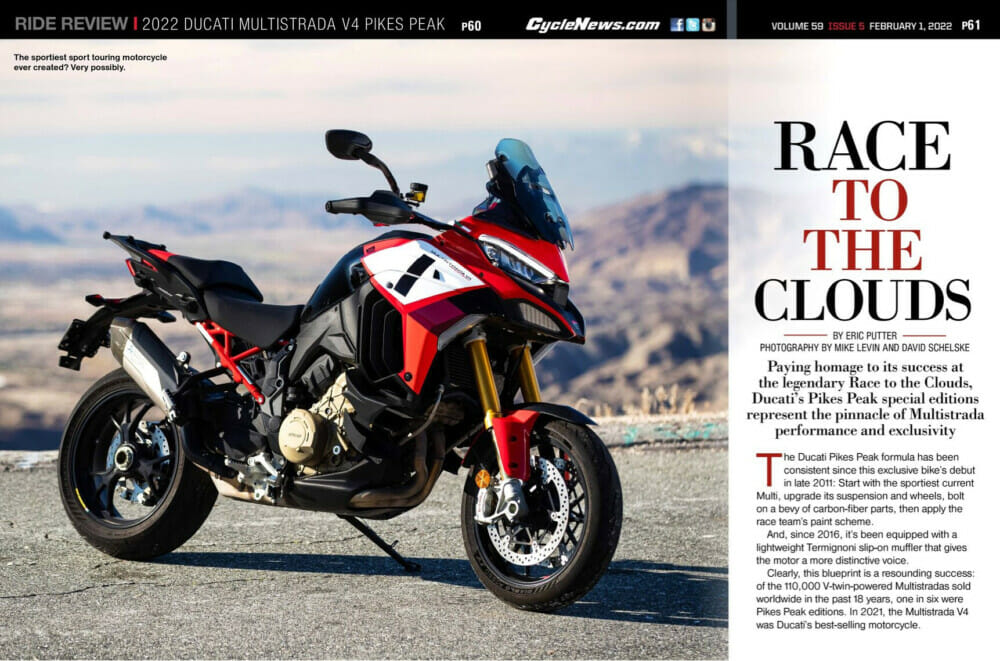
My thinking was Ducati would hang its Multistrada hat on the Pikes Peak. Why go for an even higher-spec Multi when you have something as marvelous as that? I guess that’s why I’m not employed in Ducati’s product planning department.
Fast forward to 2024, and Ducati drops the Multistrada V4 RS off in my driveway. Immediately it looks faster, lighter, more agile, and meaner than the Pikes Peak. It has that aura to it that is almost exclusive to high-end Ducatis. This really is a superbike for the discerning sport-touring rider. A bike that, let’s be honest, no one really needs.
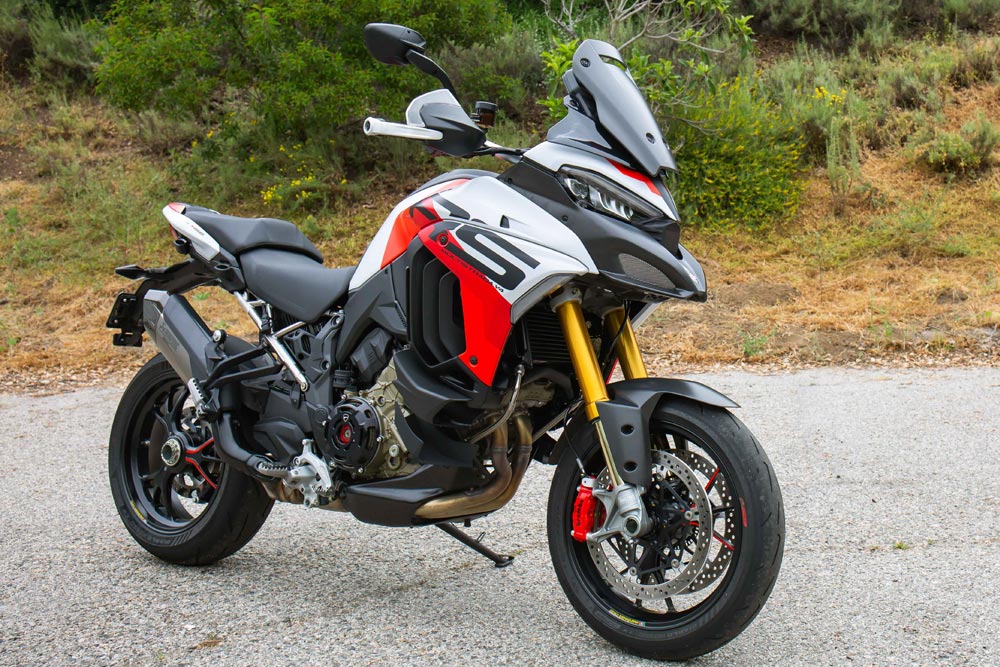 All the muscle, none of the fat. The Multi V4 RS is a serious head-turner.
All the muscle, none of the fat. The Multi V4 RS is a serious head-turner.
Photography by Ryan Nitzen
The original V4 Multi is better at Multistrada-ing than the V4 RS in almost every way. It’s comfier, roomier, and plenty fast enough, but I guess I didn’t consider the buyer who wants an RS just, well, because. Think of the guy who has a Porsche Cayenne Turbo GT or a Rolex Daytona, or both.
Ducati says the RS exists because they “want to elevate the Multistrada V4 to a more exclusive level and to deliver a new status symbol.” What Ducati has done is essentially turn the Pikes Peak up to 11, eking out as much performance as it possible/usable in a platform designed to cover large miles in relative comfort, with Blind Spot Detection (BSD) and Adaptive Cruise Control (ACC) to boot. You got to be safe.
The 1103cc RS engine is swiped from the Panigale V4 S superbike, and although the capacity has dropped 55cc in relation to the Multistrada V4 S, the RS’s motor delivers an eye-watering 180 horsepower at 12,250 rpm, marking a 10 horsepower increase with an extra 2250 rpm to play with.
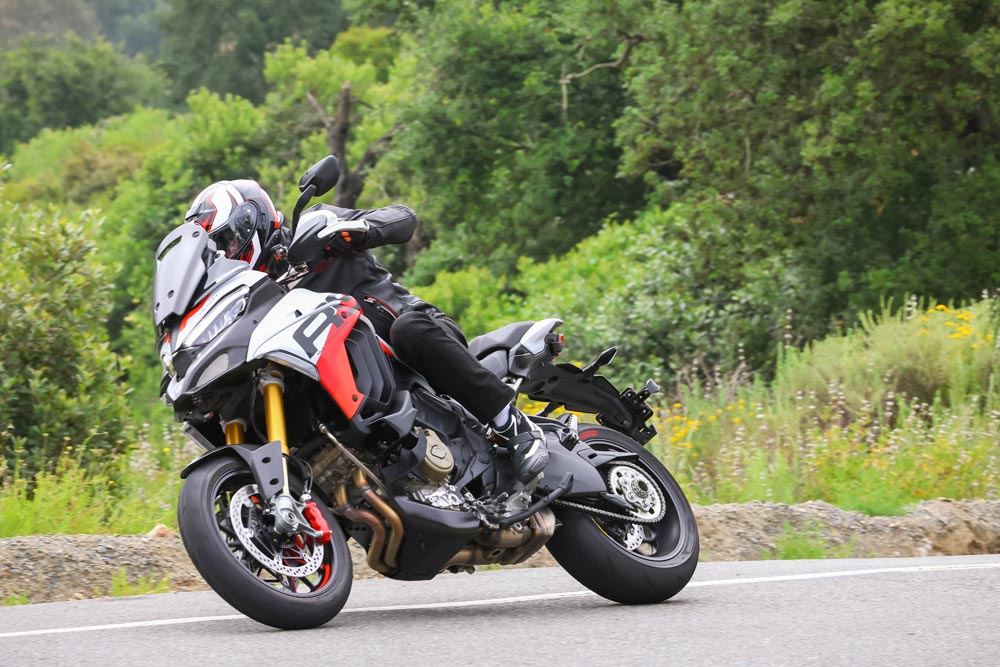
The torque has also been upped five pounds-feet to 87 lb-ft and taken 750 rpm higher than the base Multi V4.
You’ve got a 50mm throttle body for the RS, down 2mm compared to the Panigale and Streetfighter V4, and the same air filter as the Panigale; however, the acceleration for a bike weighing a claimed 496 pounds wet and designed to cover large miles in comfort is astonishing.
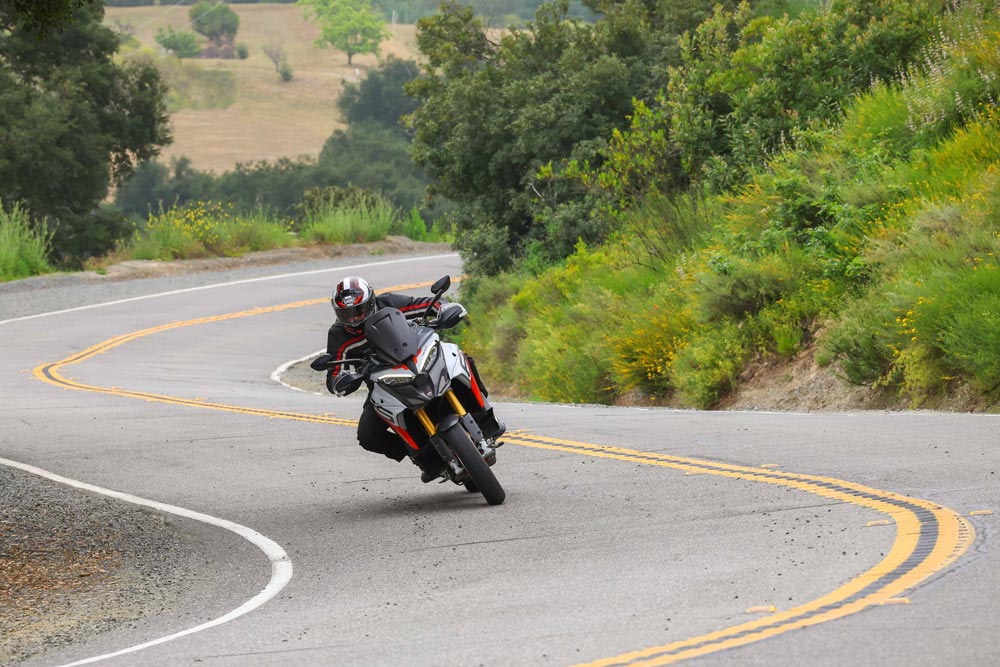 Under 500 pounds for a bike this big makes for serious agility in the twisties.
Under 500 pounds for a bike this big makes for serious agility in the twisties.
The V4 RS is more than happy to cruise around below 4000 rpm, but ride it like a superbike—as in, rip the throttle open—and you’re met with a huge level of forward thrust. The RS’s motor puts so much force through the chassis that it can’t help but lift the front wheel almost all the time, the electronics doing their level best to keep everything smooth and on line and your rubber side down.
This acceleration boost, compared to the Multistrada V4 S, is facilitated not just by the hardware of the motor but also by the drastically shorter gearing. The V4 S runs a 16-tooth front and 42-tooth rear sprocket. The RS, however, runs 15/43 numbers. Yes, those sprockets will make the motor rev higher for a given speed, but you’ll get there a damn sight quicker.
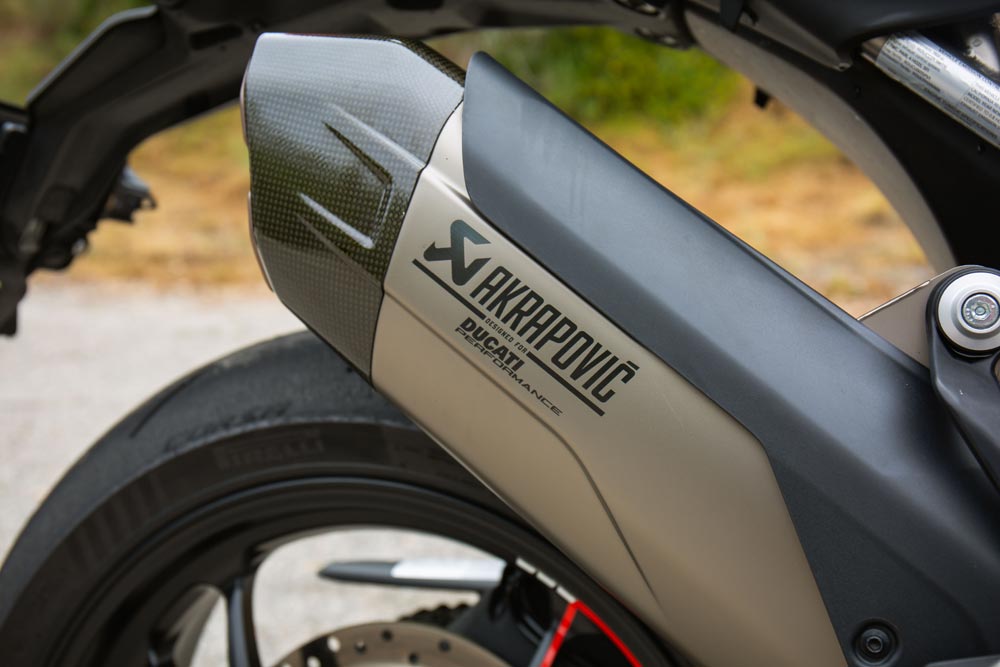 That Akrapovic titanium muffler is a thing of audible and physical beauty.
That Akrapovic titanium muffler is a thing of audible and physical beauty.
Oh, and if it’s just not fast enough, you can add the accessory race exhaust that shaves 11 pounds off and gives you a claimed 12 horsepower more. And so long as you use the Ducati Performance Oil, claims Ducati, your V4 RS will be punching out 195 horsepower.
Those who know their Ducatis will know the sound of the rattly dry clutch, a sound that has graced superbike grids the world over for decades. Ducati felt the RS deserved such a clutch, it being the STM EVO-SBK unit, which is excellent for the racetrack and near pointless for the street.
The noise it makes is not flattering, almost drowning out the beautiful sound of the masterpiece V4 at idle. The dry clutch is great for track riding because it has no resistance from engine oil and smooths out corner entries under braking, but it doesn’t make enough of a difference for me over a traditional oil-bathed clutch to warrant its fitment, especially given the greatly increased racket.
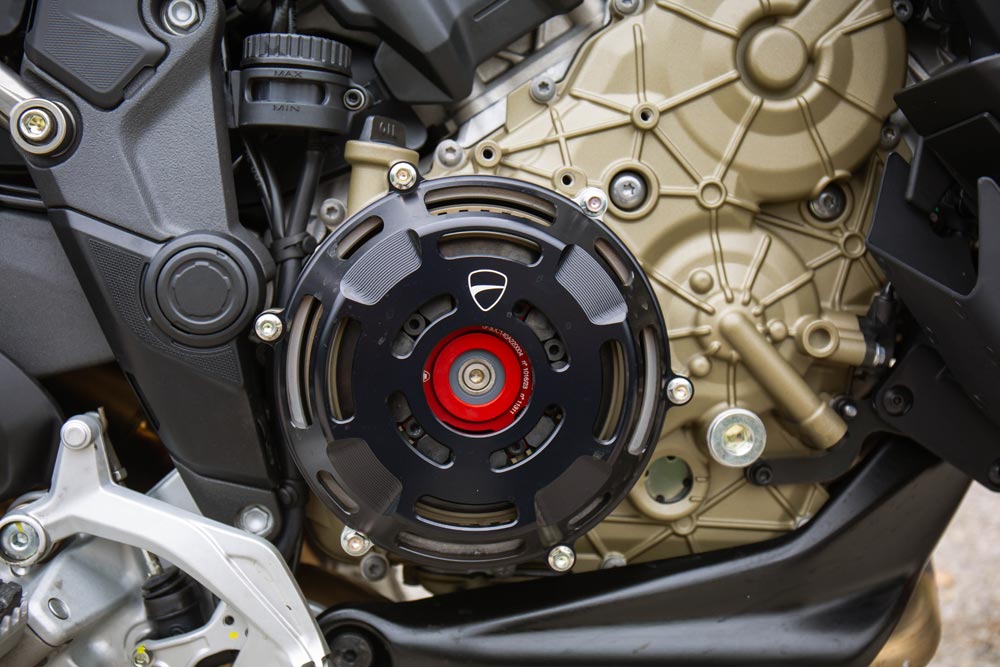 The Ducati dry clutch. Some love it, but we feel it’s not needed for a bike of this designation. It’s so loud it almost drowns out the sound of the V4.
The Ducati dry clutch. Some love it, but we feel it’s not needed for a bike of this designation. It’s so loud it almost drowns out the sound of the V4.
This being the highest-end Multistrada, you’d expect there to be copious weight- saving measures employed by Ducati, and you’d be right. Compared to the base model Multistrada V4 S, the RS is a claimed 15.4 pounds lighter. Marchesini forged aluminum wheels save a claimed six pounds, a titanium subframe saves a claimed 5.5 pounds, a smaller lead acid battery (not a lithium-ion unit, oddly) drops another 3.1 pounds, and there are acres of carbon fiber in the stumpy screen intakes, front wheel guard, hand guards, and probably a lot more I’ve missed.
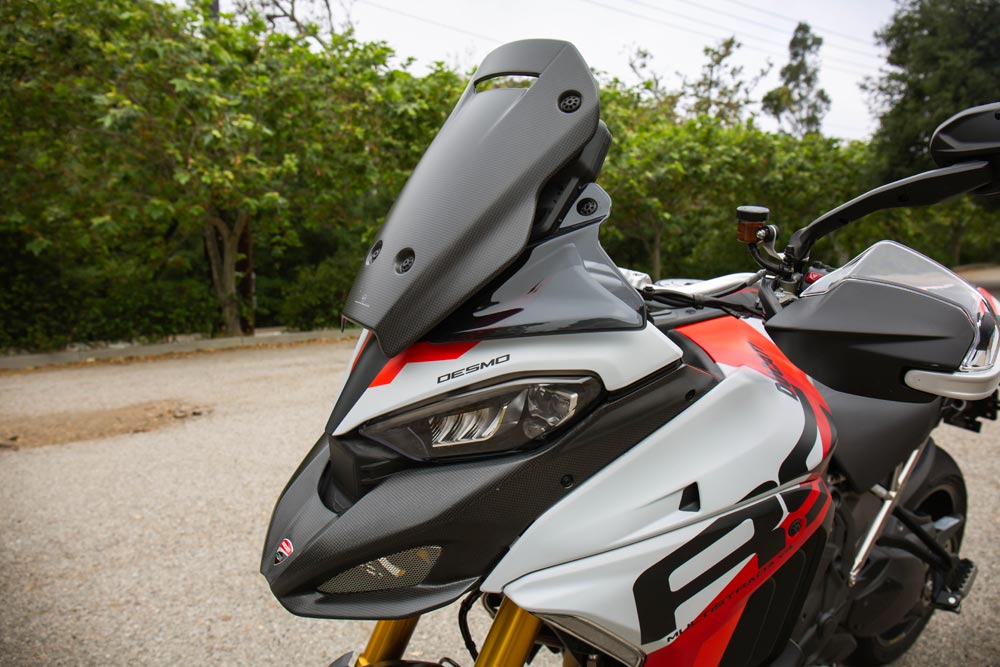 Carbon fiber is caked on the RS, and we’re all the happier for it.
Carbon fiber is caked on the RS, and we’re all the happier for it.
And if you’re wondering, the RS is a claimed 6.6 pounds lighter than the Pikes Peak Multi V4.As a result, you’ve got an incredibly agile machine to play with in the RS. Like a heavyweight boxer that’s as quick as he is powerful, the RS turns with far greater speed than the base V4 S. Laden with Pirelli Diablo Rossi IV Corsa 17-inch rubber, edge grip is unquestioned. Here is where the real teeth of the RS shine through. Brake hard, turn hard, accelerate hard—just like you would on a superbike—but with more comfort. Perhaps I am starting to see the benefits of the bike no one needs.
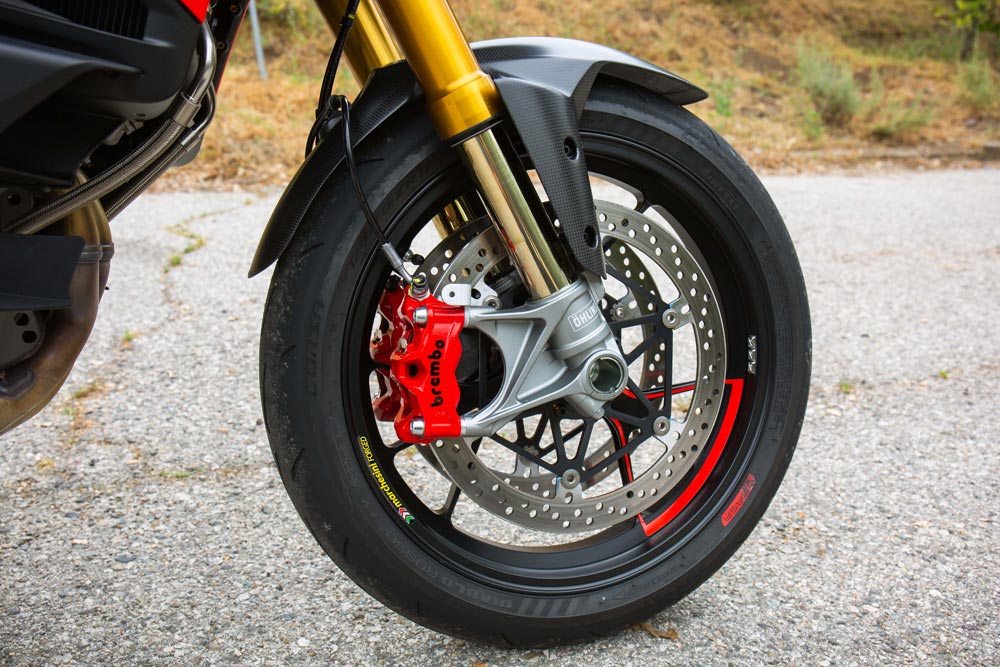 The brakes are the same as the Pikes Peak but with red calipers. Red calipers make you stop faster, right?
The brakes are the same as the Pikes Peak but with red calipers. Red calipers make you stop faster, right?
The RS runs the same Öhlins Smart EC 2.0 event-based electronic suspension software for the 48 mm Öhlins fork and Öhlins TTX36 shock as the Pikes Peak, although that bike came out two years ago, and there’s been a bit of calibration gone on since then to refine the system.
As far as preload goes, you’ve got the regular single rider, single rider with luggage, two riders, and two riders with luggage settings on the V4 RS as on the Pikes Peak. Each higher step gives you a proper difference in overall stiffness, with the bottom (single rider) being very/too soft and the top setting (two riders with luggage) being very stiff. It’s up to you where you’d like to end up.
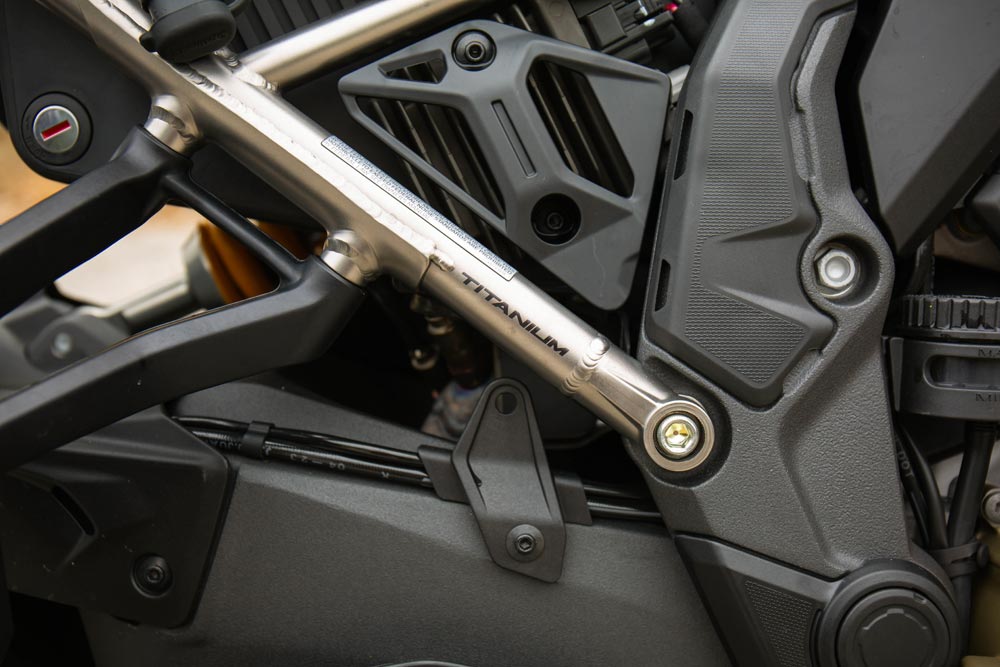 The best-looking subframe on the market? We think so.
The best-looking subframe on the market? We think so.
The event-based software on the V4 RS is different to the system on the Panigale, which is more track-focused in its menu options. The Panigale allows for braking, cornering, and acceleration “events” to be altered, whereas the Multi RS allows for front or rear suspension to be set at from Hardest, Hard, Medium, Soft or Softest, with the needle on the dash swinging between Performance and Comfort, depending on how stiff you go, and it doesn’t matter what ECU mode (Race, Sport, Touring, etc) you’re in, you can still play around with the suspension if you want.
In the name of science, I went both ways and tried the Hardest setting on the front and rear and Softest front and rear, and, you guessed it, the bike was damn near unrideable in both instances. For the kind of riding I was doing on the V4 RS, which was mainly fast canyon riding with plenty of highway stretches, the best setting for me was two-thirds of the way up towards the “Performance” end of the scale, with preload set and one rider with luggage to give it a bit more support. But each to their own. The system is easily changed around, and Ducati has done an excellent job with the user experience of the electronics.
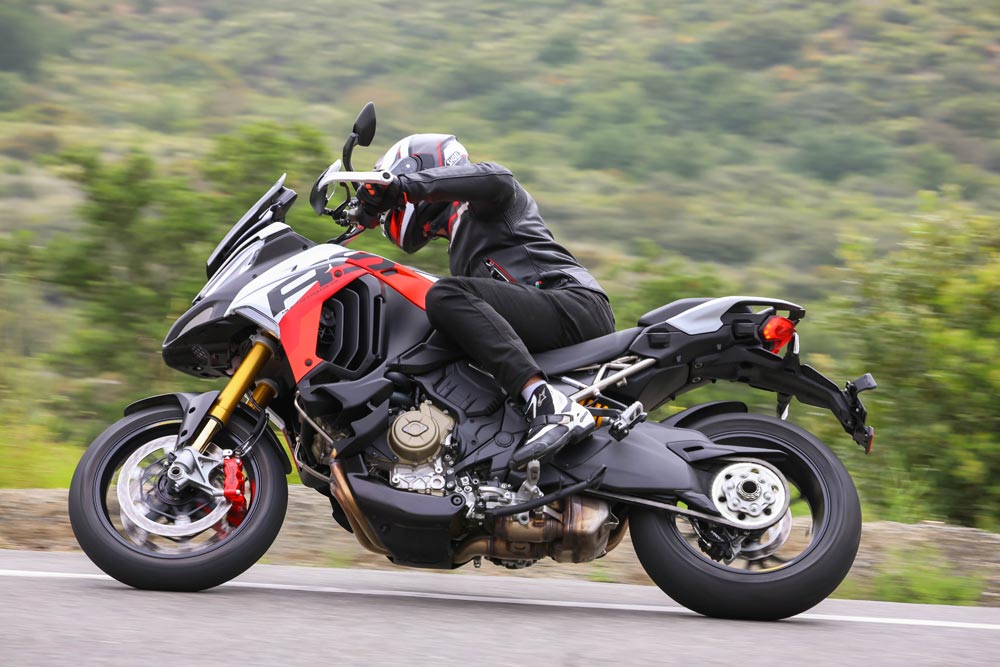 All- day comfort is not the V4 RS’s strong point. The seat gets very hard after 45 minutes on board.
All- day comfort is not the V4 RS’s strong point. The seat gets very hard after 45 minutes on board.
Speaking of, all the stuff you’d expect from the tech boffins is there, like the Bosch six-axis Inertial Measurement Unit, Cornering ABS and TC, wheelie control, Adaptive Cruise Control and Blind Spot Detection, and Brake Slide Control. None of this stuff is new, so I won’t go into much detail on it here.
The V4 RS is a stupendous motorcycle, of which there is little doubt. I still stand by my assertion that no one really needs this bike, but I think you could say that about a V4 Superleggera. And, like that wonder of carbon fiber, I’m very happy the Multi V4 RS exists. It’s a $37,995 hyper tourer, exclusively numbered, for the rider that has everything.CN
VIDEO | 2024 Ducati Multistrada V4 RS First Ride
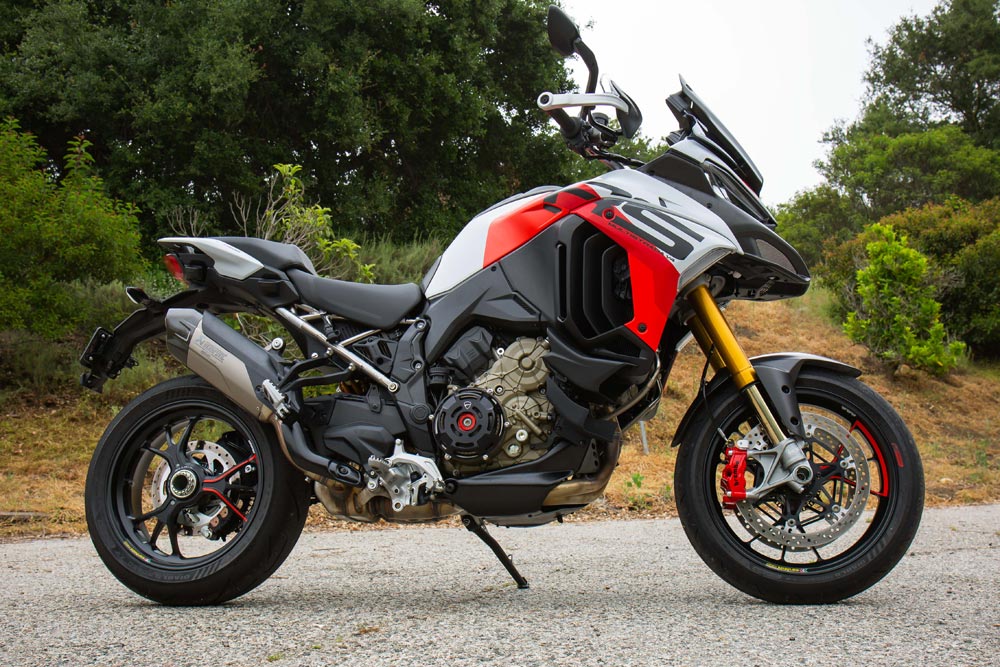
2024 Ducati Multistrada V4 RS Specifications
| MSRP |
$37,995 |
| Engine |
Ducati V4 Desmosedici Stradale, V4 – 90°, counter-rotating crankshaft, twin pulse firing order, semi dry sump |
| Valvetrain |
DOHC, 4 valves per cylinder |
| Displacement |
1103cc |
| Bore x stroke |
81 x 53.5mm |
| Cooling system |
Liquid |
| Fuel injection |
Electronic, twin injectors per cylinder, full ride-by-wire 50mm elliptical throttle bodies, fixed-length intake system |
| Compression ratio |
14.0:1 |
| Power (claimed) |
180 hp at 12,250 rpm |
| Torque (claimed) |
87 lb-ft at 9500 rpm |
| Exhaust |
4/2/2001 |
| Transmission |
6-speed with Ducati Quick Shift (DQS) up/down |
| Clutch |
Multiplate dry clutch with slipper action on over-run |
| Electronics |
Riding Mode, Power Mode, ABS Cornering, Ducati Traction Control, Ducati Wheelie Control, Ducati Cornering Light, Ducati Brake Light, Vehicle Hold Control, Radar system (Adaptive Cruise Control + Blind Spot Detection), Öhlins Smart EC 2.0 electronic suspension, Ducati Quick Shift, Hands-free, Backlit handlebar switches, 6.5″ TFT color display with Ducati Connect and full-map navigation system, full LED headlight |
| Chassis |
Aluminum monocoque; titanium subframe |
| Front suspension |
Electronic, semi-active Öhlins 48mm fully adjustable USD fork with TiN treatment, compression and rebound damping adjustment via Öhlins Smart EC 2.0 event-based mode |
| Rear suspension |
Electronic, semi-active Öhlins TTX36 fully adjustable monoshock with compression and rebound damping adjustment via Öhlins Smart EC 2.0 event-based mode; aluminum single-sided swingarm |
| Front brake |
Dual 330mm semi-floating discs, radially mounted Brembo Monobloc Stylema 4-piston, 2-pad calipers, radial master cylinder and Bosch-Brembo 10.3ME Cornering ABS |
| Rear brake |
265mm disc, Brembo 2-piston caliper with Bosch-Brembo 10.3ME Cornering ABS |
| Front tire |
Pirelli Diablo Rosso IV 120/70 ZR17 in. |
| Rear tire |
Pirelli Diablo Rosso IV 190/55 ZR17 in. |
| Rake |
25.75° |
| Trail |
4.7 in. |
| Wheelbase |
62.7 in. |
| Seat height |
33.1-33.9 in. |
| Fuel capacity |
5.8 gal. |
| Weight (wet, claimed) |
496 lbs. |
